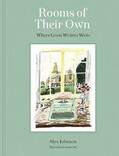
When I celebrated my birthday this month, one of my kids gave me a copy of Rooms of Their Own: Where Great Writers Write, by Alex Johnson. Illustrated with colorful, loose pen and watercolors by James Oses, this book shares the writing rooms that fifty famous authors used to create their works, and offers glimpses into their writing methods, routines and habits. It’s made me think a bit about my own space.
When I’m at home, my writing is a bit of a mobile project. I move between a round table or drop-down desk in a study in the northwest corner of my home, and a lowered section of countertop in my pantry. Each has its own appeal. The round table has a lovely view north, over mountains and valleys. The drop-down is a convenient place to hide away my laptop and all my reference materials when I just can’t look at them anymore. Both are close to the router and printer, so they’re the best place if I’m making copies to read aloud or for future reference. The desk in the pantry is close to the kitchen and has the best room if I need to spread out materials. Sometimes I work from all three spaces in a single day. There are other times when I inhabit just one space for weeks on end.
I’ve been housesitting in Maine for the past month. There is a study in this house, but it is cold enough that I find my fingers going blue at the tips. I’ve done most of my work while sitting at a dining room table that looks out at a lake. I’ve seen that lake in full color, with green grass and a brilliant blue sky. It’s been so muted that I swore I was looking through a black and white filter. The water has been fully liquid, fully frozen, and many permutations in between: rippling with waves, smooth as glass, riddled with cracks, coated with snow.
I’ve been housesitting in Maine for the past month. There is a study in this house, but it is cold enough that I find my fingers going blue at the tips. I’ve done most of my work while sitting at a dining room table that looks out at a lake. I’ve seen that lake in full color, with green grass and a brilliant blue sky. It’s been so muted that I swore I was looking through a black and white filter. The water has been fully liquid, fully frozen, and many permutations in between: rippling with waves, smooth as glass, riddled with cracks, coated with snow.

Looking out on the lake has been especially inspiring to me because one of the pieces I’m working on is set on Isle Royale, an island in Lake Superior that is now a national park. My story takes place during the Depression, and the characters are families that live on the island full time and make their living by fishing. I worked on chapters set in the dead of winter, when the island is cut off from the mainland by huge, destructive ice floes. Frozen lakes aren’t something this New Mexican has experienced much. Neither is walking through mixed deciduous and evergreen forests. Even though I live with my back up against a national forest, it is primarily ponderosa and fir, evergreens that keep their needles and their shape throughout the winter. Here in Maine, a good 50% of the trees have lost their leaves. Combined with the frozen streams that run through the woods, the forest here seems a lot more bleak and desolate than the one I’m used to. It’s helped me add a lot of depth to my book’s setting.
I am not the only writer who becomes inspired by bleak surroundings. Rooms of Their Own tells me that George Orwell wrote Nineteen Eighty-Four while in self-exile on Jura, and island in Scotland’s Inner Hebrides. The environment was harsh, and Orwell had few creature comforts. He lived spartanly, moving about the house, from sitting room to attic, to bedroom, to work where inspiration hit him. Although the austerity of his lifestyle was doubtless inspirational for his work, it was hard on his body; Orwell was suffering from tuberculosis, and the cold, damp air and his chain-smoking made his condition worse.
I am not the only writer who becomes inspired by bleak surroundings. Rooms of Their Own tells me that George Orwell wrote Nineteen Eighty-Four while in self-exile on Jura, and island in Scotland’s Inner Hebrides. The environment was harsh, and Orwell had few creature comforts. He lived spartanly, moving about the house, from sitting room to attic, to bedroom, to work where inspiration hit him. Although the austerity of his lifestyle was doubtless inspirational for his work, it was hard on his body; Orwell was suffering from tuberculosis, and the cold, damp air and his chain-smoking made his condition worse.

Victor Hugo also wrote while in exile, although his was political. Hugo got himself crossways with Napoleon III, so he moved to Guernsey in 1855. Over the next fifteen years, he wrote from a room he built at the top of his house. The room had windows on three walls and a glass ceiling that made it frigid in winter and broiling hot in summer, but it also gave him a view of the sky and the sea, and on clear days, his beloved France. Hugo wrote Les Mierables and Toilers of the Sea from this room.
Tomorrow I’m leaving my own self-imposed exile and heading back to New Mexico. I’m looking forward to being home again, to trading mountain views for lakes and ponderosas for poplars. But I’ll be bringing the experiences I had back with me and they’ll find their way into my writing.
Tomorrow I’m leaving my own self-imposed exile and heading back to New Mexico. I’m looking forward to being home again, to trading mountain views for lakes and ponderosas for poplars. But I’ll be bringing the experiences I had back with me and they’ll find their way into my writing.
Jennifer Bohnhoff writes historical and contemporary fiction for middle grade through adult readers from her home high in New Mexico's central mountains.






No comments:
Post a Comment